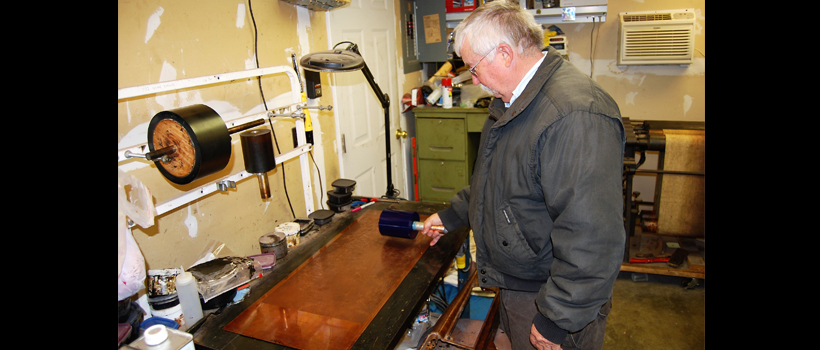EDITOR’S NOTE: The following blog was written by John Gunnell, owner of Gunner’s Great Garage Restoration Shop in Manawa, Wisconsin. Gunnell regularly contributes articles and industry-driven observations for THE SHOP magazine and eNewsletter.
On the way to the Performance & Racing Industry Trade Show in Indianapolis, I made a stop in Lafayette, Indiana, to drop off some 1948 Chrysler Saratoga parts at a small garage that houses a business called Woodgrain by Estes. This company’s business plan is pretty simple: It is the only outfit that can woodgrain metal car parts the same way it was done at the factory some 70 years ago, according to owner Joe Goss.
Woodgrain by Estes uses a French process known as Gravure printing to put a woodgrain finish on parts like dashboards and window frames. Plates with various grain patterns on them are an important part of the system. Woodgrain by Estes has over 400 plates that originally belonged to National Cash Register Co. (Yes, cash registers used to be woodgrained years ago.)
A machine with large metal rollers, a hand-held rubber roller and special inks are used to pickup the grain patterns from the plates and transfer them to the car (or cash register) parts. If Woodgrain by Estes has plates for the old car you’re restoring, they can woodgrain the metal parts just like the factory did.
Packard is one automaker that used woodgrained metal parts in its cars. One member of a Packard Internet bulletin board wrote: “Woodgrain by Estes is the absolute best, bar none. Joe Goss, who now owns the company, learned from Bernie Estes. They use original plates from the day. Plates-and-rollers was the system originally used to woodgrain Packard parts, at least in 1939-1942.”
It took me over a year to find a tiny Woodgrain by Estes advertisement in a collector magazine. We also investigated several other processes from hand graining with a brush to aqua transfer systems. The 1948 Chrysler window frames were the reason. They had a straight grain on the bottom section and a radial grain on the top. The aqua transfer system could only do straight grains.
We could have had beautiful woodgrains with the other systems, but no one could promise factory-correct graining, which is what the 1948 Chrysler owner (one of our best customers by the way) wanted. When we contacted Goss to ask if he could woodgrain the parts like the factory, he said to take a photo of the parts and email it to him. Then, he called to say he had those plates.
Woodgrain by Estes maintains a book that documents what kinds of cars it has done parts for in the past. The book contained information about the proper plates to use to do a 1946 Chrysler six, but did not have information for a 1948 Chrysler like our customer’s car. Of course, Goss will now make up a new page for the 1948 Chrysler Saratoga eight three-passenger coupe and put it in his file.
That alone serves as a definite reminder the need to describe a car very specifically and completely to ensure getting the proper woodgrain. In some cases, a certain grain might be right for a maroon eight-cylinder coupe, but completely wrong for a green six-cylinder sedan. The more accurately you describe the car you have, the better chance you have of getting the right grains.
To learn more, contact Woodgrain by Estes at 765-427-7078.
